So, we reach the end of the Supreme Directors with a short walk dedicated to Juan Pedro Julián Aguirre y López de Anaya, more commonly just referred to as Julián Aguirre. There’s not a huge amount to tell about him, and in fact I was able to find out little overall. He was a revolutionary military officer, who rose only to the rank of Captain, unlike most of the other Supreme Directors who seemed to have made it to higher ranks. And, when it comes down to it, he wasn’t actually elected to the position – at the point in time in 1820 when Argentina decided to create a national constitution and democratically elect a president, our erstwhile repeat Director, José Rondeau, was back in the position, and he didn’t like the direction the country was going. He was forced to step down a mere four days before the new president-elect was to take office, and our boy Julián was thrown into the breach to cover the gap from late in the day on February 11 until the morning of the 16th, when the government, as it was, was dissolved. To the best I can determine he really did nothing more than hang out and take care of minor daily business.
So it’s not a surprise that it’s difficult to find a street to walk on named after him. There’s a street simply called Aguirre, but no first name and I wasn’t able to find out if this was our guy. There is a one-block long street out in Mataderos that is indeed called Julián Aguirre, and I’d assume that’s the right one, but, to be honest, and especially after my little recent venture in the Koreatown area, the street appears to be dead center of a section of the neighborhood in which I don’t plan to walk – so that block will just have to languish without me. Therefore, although it’s quite possible that the 17 block stretch of, simply, Aguirre, has nothing to do with our last Supreme Director, I’m going to use it for this little trek – besides, it’s actually, though short and primarily residential, a moderately interesting street that passes through Villa Crespo.
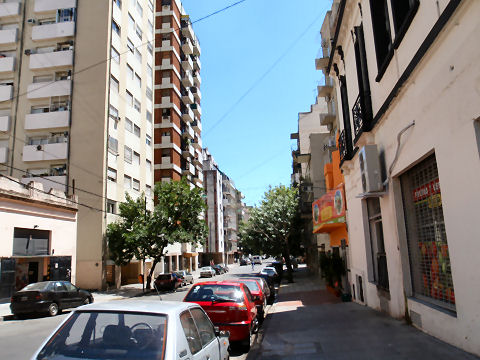
As noted, the street is primarily residential, particularly at the beginning of the walk, where it begins at the “five corners” of Corrientes, Estado de Israel, Angelo Gallardo, Troilo, and Aguirre.
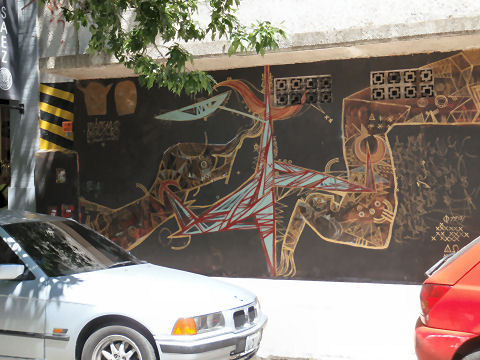
In fact, the most interesting part of this section of the walk, the first few blocks is some of the graffiti. The architecture is pretty basic and, well, boring.
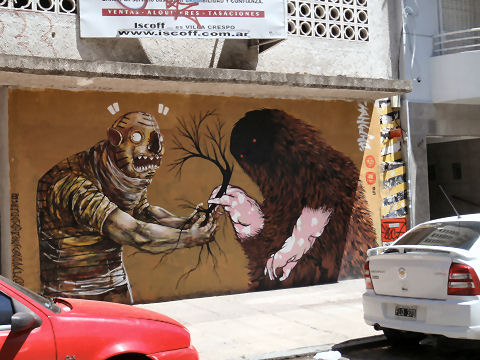
I mean, that’s pretty impressive “graffiti”, no?
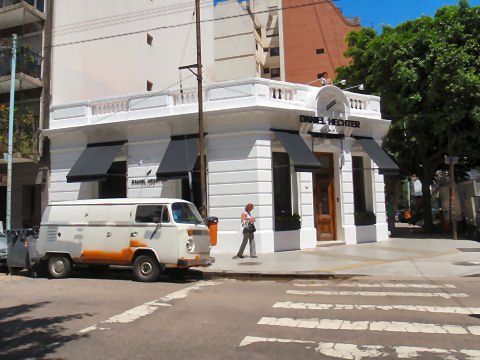
What Aguirre does seem to be known for commercially, is a four block stretch in the middle that’s jam packed with outlet stores. I’m a Daniel Hechter fan, so now I know where to shop!
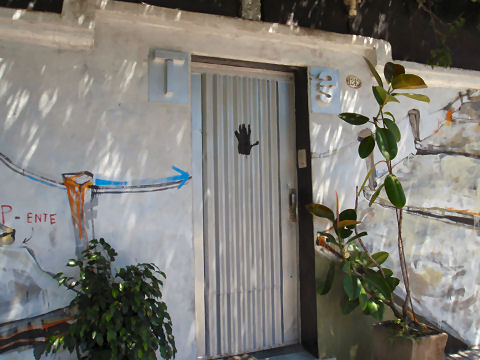
Never much of a secret since they openly advertise their address and are open, these days, regular restaurant hours most days, and we include it amongst our “puertas cerradas” kin because it started that way, this is the entrance to Almacén Secreto, at #1242 – more than halfway through our walk already. I’ll have to ask one day what the whole black hand on the door, and the “T Cul de Sac Sala” opposite the “AS Club” mean. I’m assuming they’re not members of the secret Serbian military society….
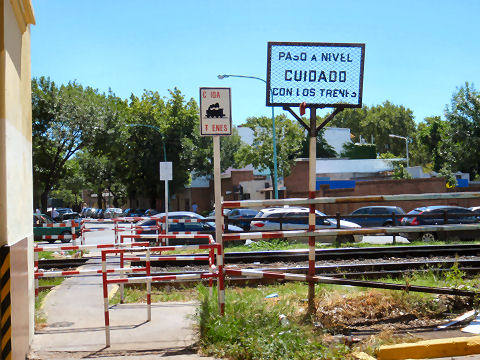
Almost to the end of the walk, at the 1400 point, we cross the tracks of the San Martín suburban train line.
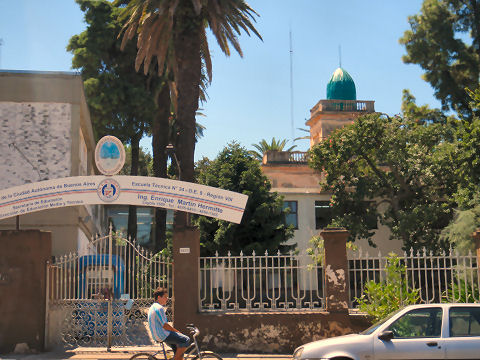
At the corner of Bonpland, this once quite pretty, it appears, technical school, specializing in electromechanics and construction. Named after Enrique Martin Hermitte, who lived in the first half of the 20th century here, an engineer, and who is credited with the discovery of petroleum reserves in Argentina. He was also the director of the Ministry of Mining and Hydrology.
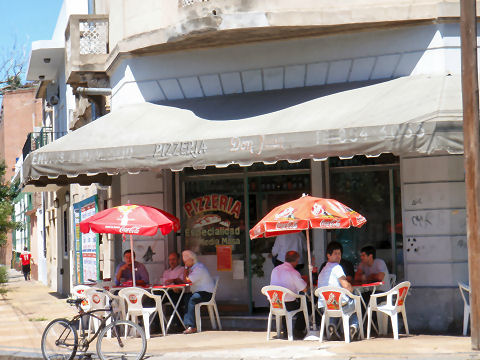
There has been little in the way of dining establishments along this walk – a cafe, an event salon, a couple of pizzerias – in fact, this is the only one that seemed to be open and populated with customers – at the far end of the walk.
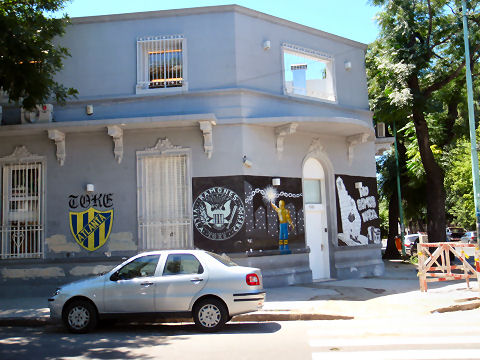
Anthony Bourdain would approve – “Ramones – Villa Crespo”….
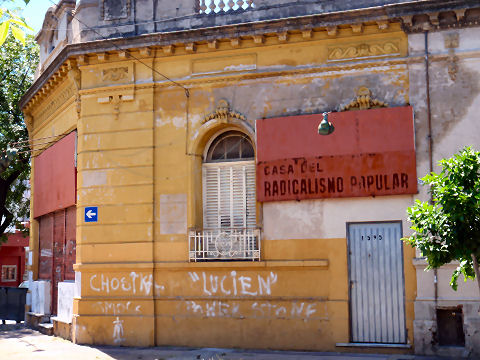
Just exactly what is “Popular Radicalism”? And why does it need its own house?
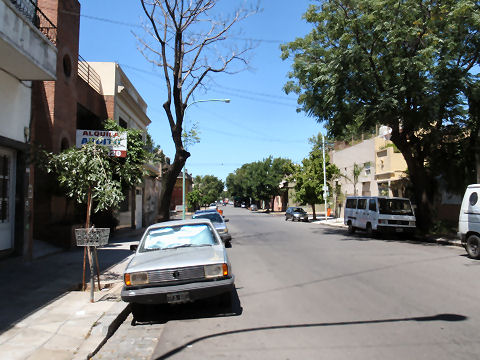
And, looking back from the end of the 1700s, it still seems pretty much just a quiet residential neighborhood.
Now, I have to decide. I’d thought about continuing along this little venture and moving into the duly elected presidents, military leaders, etc. But I’m faced with the daunting task then of the first president, Bernardino Rivadavia. The avenue named after him is one of the three longest streets in the world, starting down near Puerto Madero and continuing to the Andes in the west of the country. Now, even if I limit it (which I would) to within city limits, it’s still a twelve kilometer (7.5 mile) stretch that would obviously require not only a huge amount of time to walk and catalog, but multiple posts. So, input? It is actually a pretty interesting street, it just might take a bit to get through it….
Yes, please do continue. I’m sure I’m not the only one who really enjoys these mini travelogues- always interesting, and most informative.
Because Rivadavia cuts across the city as it does, the changing scene may be interesting. Yesterday I noticed some really beautiful old buildings in streets I wouldn’t even have looked at if it hadn’t been Saturday earlyafternoon and empty. And its watershed function (streets change their name as they cross it) may make it necessary to consider both sides carefully. It may take longer than you plan, it isn’t a barrio, but usually commercially the most important street in the neighborhood and as I said before, a divide (“that’s on the other side of R”, etc.). Anyway, good luck. Btw, have you done Coghlan already? I got lost there once and found an incredible graffiti, must try and find it again…
Mary, indeed, it’s a fascinating street – originally known as “the spine of Buenos Aires” – because it’s the zero point for the streets that branch off it in opposite directions (all streets that cross Rivadavia change their names and reverse the counting of addresses in the opposite direction). Well, perhaps it is a worthwhile project to undertake – and I’ve certainly done other walks that were around 2 kilometers in length for writeups – so this could get broken into somewhere between 4-6 sections.
[…] left behind our Supreme Directors with the short-lived 4 day and some hour tenure of Julian Aguirre, the government of Argentina, as […]
[…] is… El Timón de Pandy, Aguirre 101 at the corner of Frias, which I’d spotted on my little wander a few weeks back – it was in the process of being renovated or painted or something – […]